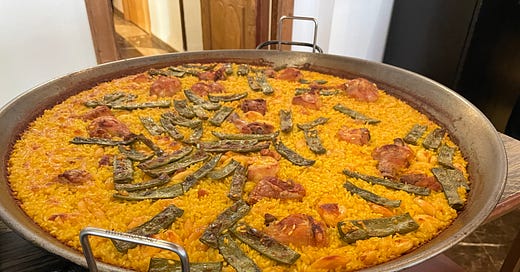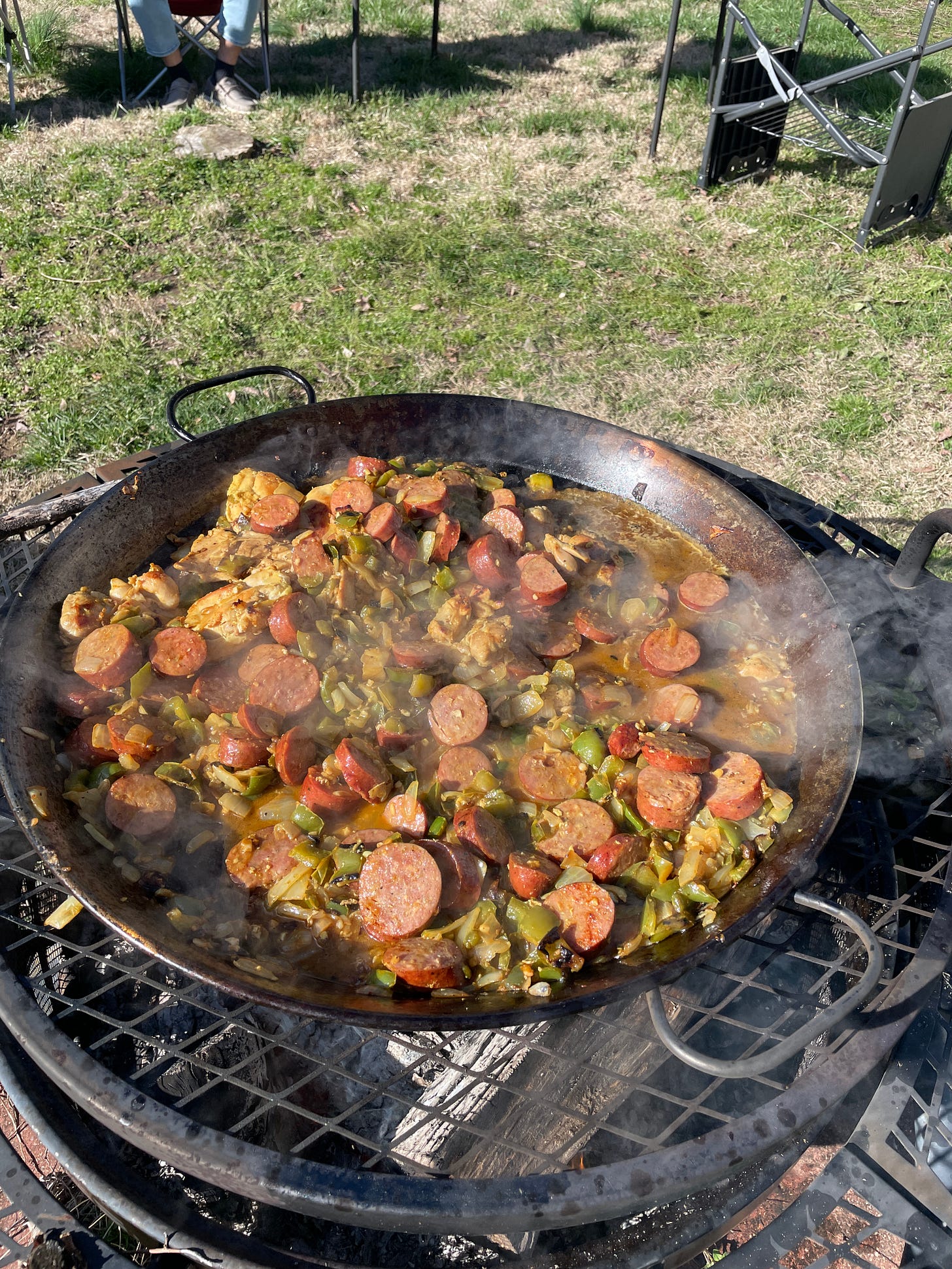Paella in Valencia - and at Home
Every home cook should try making this simple and delicious rice dish.
One of our favorite dishes to make at home on open fire is Spanish paella, albeit with somewhat Midwest ingredients. This was also one of the dishes I was most excited to try while in Spain with my daughter. We both love this traditional rice dish… no matter what ingredients are used.
We were blessed to have this in Madrid and Valencia, but the presentation in Valencia was incredible. It was served for dinner in our hotel, but the chef made sure to present it in a large paella pan just like you would if cooking for a crowd outside. To say I was excited is an understatement. No, it doesn’t take much for me to get a little giddy where food is concerned.
This was also the most fun meal because the paella was served with chunks of rabbit meat and chicken legs. For most of the teenagers, the thought of biting into “Thumper” was a bit nauseating, but many dove right in, taking in the experience like troopers. I’m happy to say that Phoebs was one who jumped right in and gobbled hers right up.
One ingredient did surprise me – no, not the rabbit. This version had what we call butter beans. They were salty and smoky, with just enough firmness to hold up but still be creamy on the inside. It was an unexpected and wonderful addition to the paella. I’ll be adding them to my own version from now on!
What is Paella?
Paella (pronounced pah-ay-uh) is a Spanish rice dish that originated on the shores of the Albufera River near Valencia, Spain. Early versions of the dish used whatever ingredients were on hand, such as beans, snails, rice, olive oil, and water. This was a simple dish born out of necessity.
Today, there are many different variations of paella, some more traditional than others. Popular modern ingredients include rabbit, chicken, smoked sausage, and shrimp, along with green beans and other vegetables. A satisfying paella is simple, with just a few key ingredients: fat, grain, protein, vegetable, and spice. Home cooks are more than capable of creating their own delicious version of this traditional dish.
The Pan
The word "paella" refers to the metal pan traditionally used for making rice dishes in Spain. This pan is large and round with shallow sloping sides and two handles for easy serving. Paella pans for the home range in size from 12 to 15 inches but some are much larger. If you don’t have a paella pan, any flat-bottomed shallow skillet will work. The flat bottom allows the paella to cook more evenly. A 12-inch paella pan or skillet is best for a family of four.
The Ingredients
There are no hard and fast rules when it comes to the ingredients in paella. Purists may argue that fish and meat should not be mixed, as the flavors compete. However, paella is a matter of personal preference, and you should feel free to experiment with different ingredients to find what you like best.
Some common meats used in paella include bacon, chicken, chorizo, shrimp, and mussels. Vegetables that are often added include onion, green pepper, green beans, tomatoes, peas, and garlic. Saffron is another essential ingredient, as it gives paella its signature flavor and rich yellow color. Turmeric is a less expensive substitute. You can also opt for “Spanish” yellow rice prepackaged from the grocery store.
To Stir or Not to Stir
Let me first say… I stir. At least until the last few minutes when the rice can get a nice crunch on the bottom as it rests on the pan.
The type of rice you use will somewhat determine how much you can stir the paella as it is cooking. Short-grain Spanish paella (Bomba) rice is the best choice, as it will hold its shape during cooking and produce limited amounts of starch. Arborio rice is an alternative, but long-grain converted rice should be avoided, as it can become gummy if stirred a lot.
In general, it is best to refrain from stirring paella too much once you have added the rice. This will help to prevent the rice from becoming gummy and will also allow the crust to form on the bottom of the pan, which is one of the best parts of the dish. Use a gentle folding motion when you do stir the dish to limit the amount of starch released by the rice.
Paella Tips
Remove the paella from the heat just before the rice reaches al dente. It will continue cooking as it cools and will have a better texture and flavor.
Let the paella rest for a few minutes before serving. This will allow the flavors to blend and develop.
Garnish with fresh parsley or lemon wedges, if desired.
With these tips in mind, you're sure to create a delicious and authentic paella that everyone will enjoy. So, get to cooking and let your creativity shine!
Keep reading with a 7-day free trial
Subscribe to Culinary Travelers to keep reading this post and get 7 days of free access to the full post archives.





